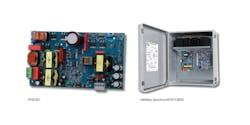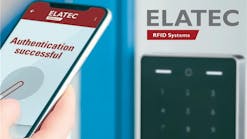Multifamily security is one of the hottest growth verticals for many security manufacturers and professionals, as property owners continue to embrace new technologies and trends within access control, many of them driven by the expectations of tech-savvy renters and condo owners who have come to expect both security and convenience.
For example, the latest Parks Associates’ multifamily research quantifies a significant boost in multifamily resident satisfaction when a property provides smart home tech, with 83% of multi-dwelling-unit (MDU) residents with property-provided smart home devices are satisfied or highly satisfied with their apartment or condo.
“New apartment construction is at historic highs, putting downward pressure on rents. Smart amenities, including connectivity and smart home solutions, can help a property compete and succeed,” says Jennifer Kent, VP, Research, Parks Associates. The research firm has been examining the impact of smart home tech on rental value among multifamily properties, and how MDU owners and managers can leverage these offerings to attract high-income residents, improve satisfaction, and add new revenues.
Parks Associates finds broadband connectivity and automated technologies are also in high demand among MDU residents and, once deployed, these solutions are popular with residents, with nearly 80% of those with property-provided smart home devices and services are satisfied with these services.
“We are really excited about the solutions we have built for our multifamily clients that address problems such as property staffing gaps, operational inefficiencies, and manual processes,” said Vickie Rodgers, vice president and general manager, Cox Communities, which partnered with Parks on a recent white paper looking at the impact of smart technology on property value.
Digital Transformation
Across the security industry, from the installation of the locks to the security of all integrated systems, the conversation is moving to providing the most seamless and secure experience for the customer while providing added value for the end user.
“Your proposition shifted from just keeping bad people out to now doing everything else [the end user] wants,” says Lee Odess, CEO of the Access Control Brief, who recently released a white paper that looks at the differences between legacy and modern enterprise-ready access control systems being employed within the multifamily market. “After COVID, there wasn't necessarily trust and comfort that the legacy system was able to do that. These newer, enterprise-ready systems can deliver on that promise because they're built cloud-, mobile-, and AI-first – they're not adding mobile, cloud in AI as like a piece attached – it's the architecture on which they're built.”
As Odess aptly points out, many verticals – hospitality, retail, multifamily, for example – within security are going through digital transformation, which is attracting more tech savvy locking and software companies to the access control space.
“Along with that digital transformation, products have to deliver value, so it is also the digitization of the product versus it just being a home control cool factor where I can use my phone to get in, or it was a way for me to differentiate as a builder to be able to charge more for rent or keep renters,” explains Odess. "Now it's an operational efficiency tool and revenue generation tool beyond the cool factor side. So yes, it's digital. This is why every vertical in our industry is going to be impacted. It happened in hospitality, it happened in multifamily, and it's happening in enterprise commercial real estate right now and it will happen in life sciences, hospitals, and the rest of it. This is the phase change of our industry that the old guard would like to pretend isn't going to happen because of safety reasons. And it is going to be disrupted where you deliver safety conveniences and then additional value on top of it.”
James Rothstein, Security Industry Association (SIA) Board of Directors chair and operating partner with Lee Equity Partners, agrees, noting, “Our industry is deeply focused on adding value – from thinking creatively about how security technologies can provide value to office property owners who are seeking to make their buildings more efficient as they adapt to a long-term trend of mobile work to support small businesses like retailers who need their security investments to serve to not only protect their operations, but also give them the insights they need on their retail performance.”
Mobile-first Mentality
With the phone becoming the credential of choice for many within the multifamily market, the way in which we view access control, in general, is changing, which is being driven mostly by the end user and consumer.
“The bigger thing that I think mobile does at this point is it introduces a new stakeholder being the end user,” says Odess. “We've never really interacted with the end user. They were a card, a Fob and a number. They're now a stakeholder that we must deal with, and the way that we deal with it is through user experience and value creation that goes beyond keeping bad people out.”
He continues, “If I'm a person that is supposed to be in that building, I interact with your system through mobile. You let me through because I'm supposed to be there. Then the expectation is that it does other things as well, like getting a locker, calling the elevator, buying stuff at the canteen. And I mean, there's a long list of added value that it can deliver in a very connected world now where I may work in four different locations, I can now open up my sort of community of buildings and places, and it's the same user experience as I go.”
As Odess points out, this seamless experience is something that both the end user, such as property owner, and their tenants, for example, want and are demanding.
“I don't have to be like, ‘Oh, which card goes with this door and am I using Bluetooth or NFC?’” notes Odess. “No, I just go. I tap and I go in and so the experience is much greater. Whereas before we weren't allowed to do that because our systems wouldn't talk to each other because their businesses were set up in a way that wouldn't allow it.”
Legacy vs. Modern Enterprise Systems
As Odess points out in his recent white paper, understanding the evolution, distinction, and definitions between legacy and modern enterprise access control systems is crucial in today's rapidly changing business landscape. “This allows organizations to make informed decisions based on their needs, objectives, and industry verticals,” he explains. “The industry can drive innovation, understanding, and progress by fostering a collaborative environment and cultivating empathy.”
The historical definition of enterprise access control systems, he adds, has paved the way for developing modern systems beyond the fundamental requirements.
“As much as our industry may protest it or deny it, modern enterprise access control systems are dramatically different from the historical enterprise access control systems many manufacturers are still pushing,” he says. “By embracing modern enterprise access control systems, organizations can enhance security, streamline operations, and meet their workforce’s and customers’ evolving needs. The features and capabilities of modern systems empower enterprises to adapt quickly, improve productivity, ensure compliance, and provide a seamless user experience. Furthermore, these systems leverage advanced technologies, such as AI and automation, to proactively address potential issues and maintain high availability.”
Odess outlines in his paper some of the key elements of a modern enterprise system – many that are being embraced by the multifamily market, and throughout many verticals within security:
· Flexibility
· Remote Management
· Unique Vertical Solutions
· Cloud-, Mobile-, and AI-First Architectures
· Automated Functionality
· Privacy by Design
· Identity Management Integration
· Platform vs. Point Solution
· Self-Heal
· Unified User Experience
· Automated Access Provisioning
· Value Driven
Modern enterprise access control systems, he adds, “enable organizations to navigate the complexities of access management, protect physical and digital assets, and create secure and efficient environments for employees, visitors, and stakeholders. By embracing the features and capabilities of modern systems, enterprises can position themselves for success in the digital age and contribute to the growth and advancement of their respective industries.”
As locksmiths continues to evolve and move into electronic access control, Odess implores them to be cognizant of what is happening with this digital transformation that is taking place within many verticals, not just multifamily.
“There's a there's a rich environment around innovation happening at the software level, but because it's not shiny and brass and bent metal, we don't want to talk about it,” he says. “That’s where the vibrant market is coming from.”
[sidebar]
Proptech Delivering Value beyond Security
The integration of connectivity and smart home technology in multifamily housing is driven by the potential for increased revenue, improved operational efficiency, and heightened resident satisfaction, according to research recently released by Parks Associates in partnership with Cox Communities.
“Property managers and builders recognize the importance of staying ahead in this evolving landscape to gain a competitive edge and maximize returns,” says Parks. “Connectivity and smart home technology are reshaping multifamily housing, with property managers and owners leveraging these innovations to enhance the resident experience and operational efficiency.”
This transformation is driven by several key factors:
· Increased Internet Demand: Evolving lifestyles have led to higher consumer expectations for internet access within multifamily properties.
· Business Benefits: Property managers and owners recognize the significant advantages of deploying smart home devices. These benefits include improved resident satisfaction, higher rental revenues, operational efficiency gains, and enhanced resident retention.
· Rental Increases: Those who adopt smart home devices can often command higher rental rates compared to properties that do not offer these amenities.
· ROI Expectations: A substantial majority (87%) of property managers anticipate achieving a return on investment (ROI) from their smart home investments within two to three years, according to Parks Associates research.
· Perceived Rental Fee Boost: Property managers believe that smart home devices can increase rental fees by anywhere from 5% to 30% according to Parks Associates research.
· Appeal to Builders: Smart home builders see multifamily housing as a promising market. They recognize that a reliable property network is a fundamental requirement when constructing smart properties. This network infrastructure allows for flexibility in adapting to changing resident needs and expectations.
· Competitive Advantage: To remain competitive, players in the multifamily housing sector must identify the most valued smart home use cases and understand how dedicated networks impact resident retention and attract high-value market segments.
· Premium Resident Experience: Offering bulk broadband, managed Wi-Fi, and IoT solutions is essential for delivering a superior resident experience. Properties that can meet advanced connectivity needs with top-tier smart solutions and services are poised to achieve the highest return on investment.
Paul Ragusa | Senior Editor
Paul Ragusa is senior editor for Locksmith Ledger. He has worked as an editor in the security industry for nearly 10 years. He can be reached at [email protected].






